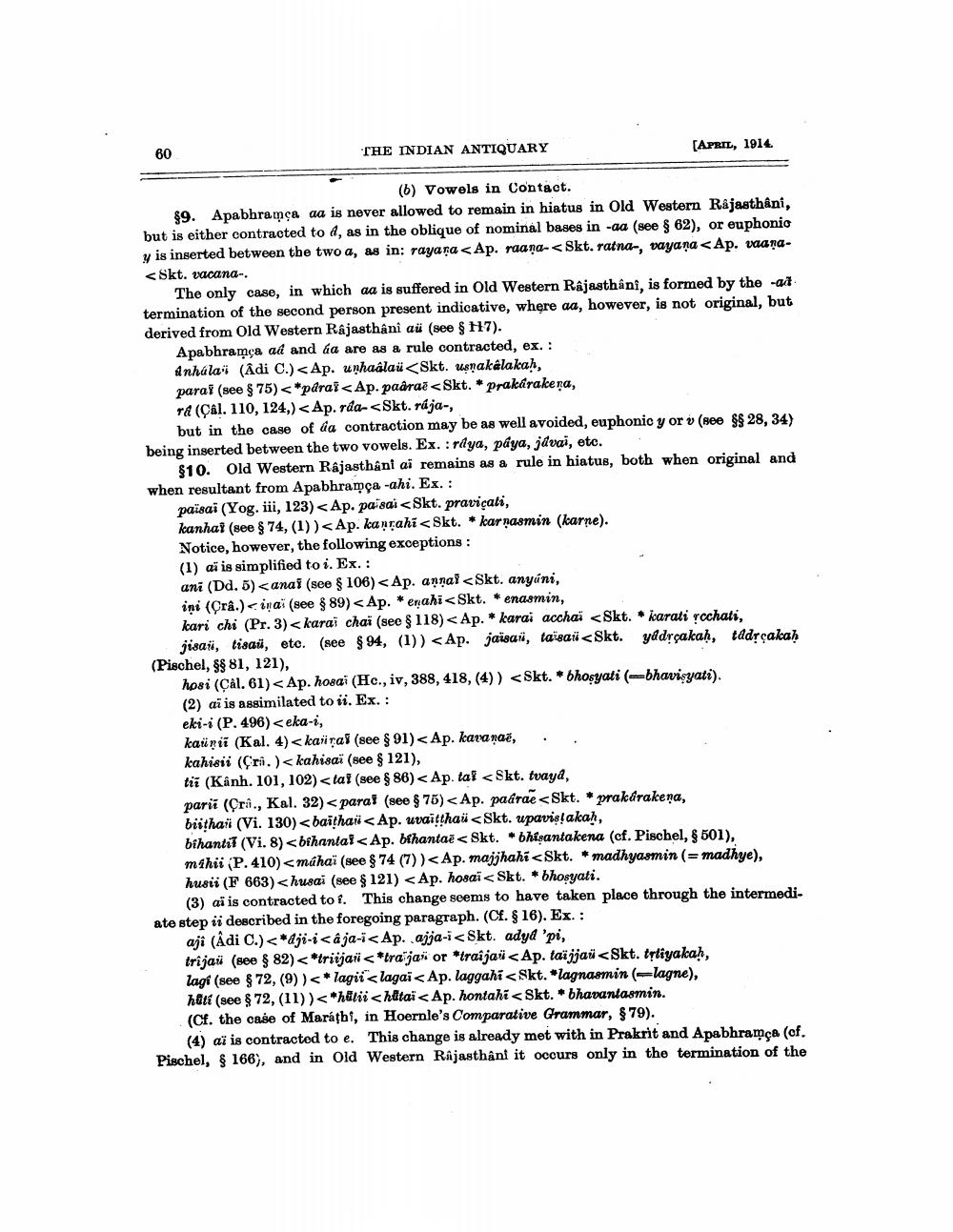________________
60
THE INDIAN ANTIQUARY
(b) Vowels in Contact.
$9. Apabhramça aa is never allowed to remain in hiatus in Old Western Rajasthani, but is either contracted to d, as in the oblique of nominal bases in -aa (see § 62), or euphonic y is inserted between the two a, as in: rayara <Ap. raana-Skt. ratna-, vayana <Ap. vaaṇa<Skt. vacana-.
[APRIL, 1914.
The only case, in which aa is suffered in Old Western Rajasthânî, is formed by the -at termination of the second person present indicative, where aa, however, is not original, but derived from Old Western Rajasthâni au (see § H7).
Apabhramça ad and áa are as a rule contracted, ex. : Anhala (Adi C.)<Ap. unhaâlaü<Skt. usnakalakaḥ, parai (see § 75) <*para? <Ap. paârae <Skt. * prakarakeṇa,
ra (Cal. 110, 124,) <Ap. rda- <Skt. rája-,
but in the case of da contraction may be as well avoided, euphonic y or v (see §§ 28, 34) being inserted between the two vowels. Ex. : raya, paya, javai, etc.
$10. Old Western Rajasthani ai remains as a rule in hiatus, both when original and when resultant from Apabhramça -ahi. Ex.:
païsai (Yog. iii, 123) <Ap. paisai <Skt. pravicati,
kanhat (see § 74, (1)) <Ap. kanrahi <Skt. * karnasmin (karne).
Notice, however, the following exceptions:
(1) aï is simplified to i. Ex.:
ani (Dd. 5) <anai (see § 106) <Ap. annal <Skt. anyúni,
ini (Crâ.) inai (see § 89) <Ap. *enahi <Skt. *enasmin,
kari chi (Pr. 3) <karai chai (see § 118) <Ap. * karai acchai <Skt. * karati rcchati, jisai, tisau, etc. (see § 94, (1)) <Ap. jaisai, taisai <Skt. yddṛçakaḥ, tadṛçakaḥ (Pischel, §§ 81, 121),
hosi (Câl. 61)<Ap. hosai (Hc., iv, 388, 418, (4)) <Skt. * bhoṣyati (-bhavisyati).
(2) ai is assimilated to ii. Ex.:
eki-i (P. 496) <eka-i,
kaunii (Kal. 4) <kairal (see § 91) <Ap. kavanaë,
kahisii (Cri.)< kahisaï (see § 121),
tii (Kânh. 101, 102) <tal (see § 86) <Ap. tai <Skt. tvaya,
pari (Crâ., Kal. 32) <parat (see § 75) <Ap. paárae <Skt. *prakarakena,
biithai (Vi. 130) <baithai < Ap. uvaiṭṭhai <Skt. upavis!akaḥ,
bihanti? (Vi. 8)<bihantar<Ap. bihantae Skt. *bhisantakena (cf. Pischel, § 501),
mihii (P. 410) <mahaï (see § 74 (7)) <Ap. majjhahi<Skt. *madhyasmin (= madhye),
husii (F 663) husai (see § 121) <Ap. hosai < Skt. * bhoṣyati.
(3) aï is contracted to ?. This change seems to have taken place through the intermedi
ate step ii described in the foregoing paragraph. (Cf. § 16). Ex.:
aji (Adi C.)ji-i<ája-i<Ap. ajja-i<8kt. ady 'pi,
trijai (see § 82) <*triijai <*traja" or "traija <Ap. taïjjaü<Skt. tṛtiyakaḥ, lagi (see § 72, (9)) <* lagii<lagai<Ap. laggahi <Skt. *lagnasmin (-lagne), hiti (see § 72, (11)) <*hilii<hitai <Ap. hontahi <Skt. * bhavantasmin.
(Cf. the case of Marathi, in Hoernle's Comparative Grammar, §79).
(4) aï is contracted to e. This change is already met with in Prakrit and Apabhramça (cf. Pischel, § 166), and in Old Western Rajasthân! it occurs only in the termination of the




